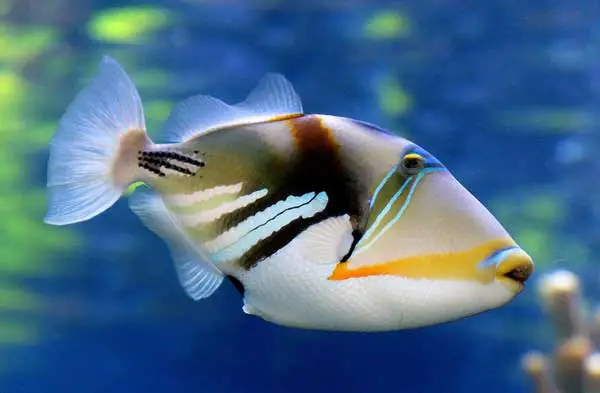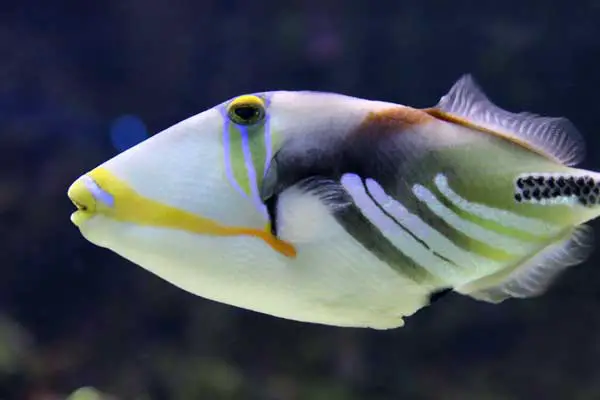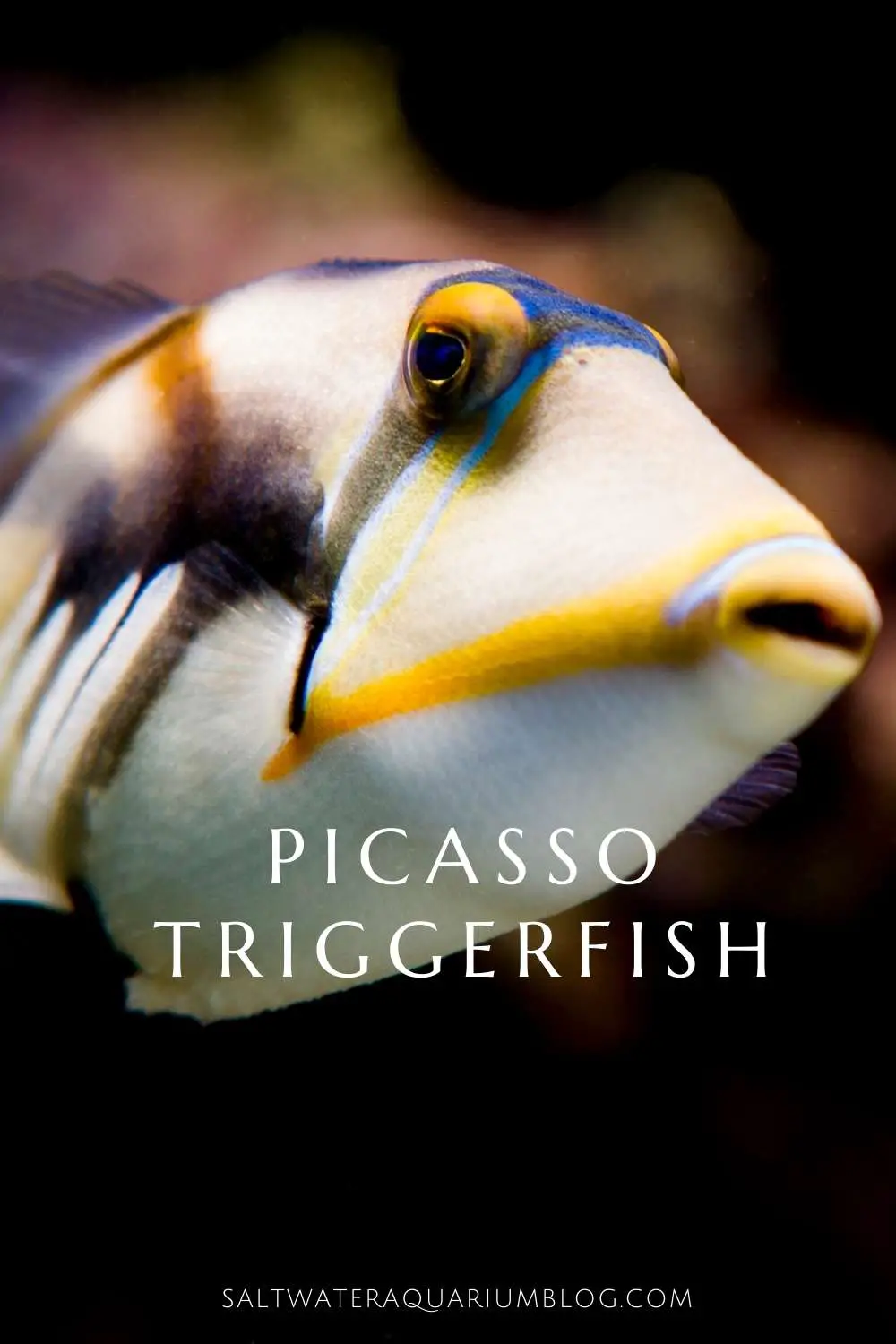Would you agree with me that the Picasso triggerfish, or Humu Humu, is truly a work of art? The fish has markings that resemble an abstract painting. As an easy to care for triggerfish, the Picasso is a very popular saltwater fish species. Want to know how to care for one in your saltwater aquarium? Let’s dive right in.
Table of contents
Quick Facts About the Picasso Triggerfish:
- Scientific Name: Rhinecanthus aculeatus
- Common Names: Humu-Humu, Lagoon Triggerfish, Piccasofish
- Hawaiian name: The Hawaiian name for this fish is humuhumunukunukuāpuaʻa
- Max Size: 10 Inches
- Minimum tank Size: 100-Gallons ++
- Aggression Level: Aggressive
- Color: Blue, White, Brown, Yellow, Black
- Care Level: Beginner
- Most Active: Day
- Lifespan: 10 Years
- Price: $75-$125, give or take
Natural habitat
The Picasso Triggerfish can be found in the Indo-pacific ocean and the red sea. Most commonly it can be seen around Hawaii, Polynesia, and the Philippines. This fish tends to be found in the sandy parts of reefs swimming around actively and generally found in more shallow parts of reefs, where there are rocks for it to hide away in. It’s the official fish of the state of Hawaii, where it is called:
humu humu nuku nuku apua’a
Or humu humu, for short. This fish is extremely territorial and guards its home against all matters of sea life. They have even been known to try and chase off divers.

Picasso triggerfish aquarium conditions & behavior
The Picasso triggerfish does well in the usual saltwater aquarium water conditions:
- About 78 degrees F
- 1.025 specific gravity
- pH ~8.2
They tend to be best kept in a fish-only environment, with other aggressive fish. Since they can grow to be 10-inches long, it’s probably best to keep them in a tank that is about 100 gallons, or larger.
The Picasso Triggerfish is incredibly territorial and will cause trouble with tank mates if it feels its home is too cramped. In the wild this fish is solitary outside the harem of females it will occasionally meet with during the breeding season.
I have seen them kept in large, relatively open fish-only tanks, but if you want to recreate their natural environment, you may want to keep them in a tank filled with live rock, where it will periodically hide in the crevices.
Picassos are famous (or is it infamous) for rearranging and redecorating your tank…because…well…they are built like a tank (the other kind). They might dig, they might chew and they might just knock stuff over.

Watch out! Triggerfish bite
Be careful when putting your hand in the tank–especially when first introducing this saltwater fish to your tank. Picasso triggerfish have been known to bite, and their teeth pack a punch…or bite…yeowch!
As mentioned earlier, humu humus are also extremely territorial, which might give them another reason to bite.
With that said, they can and will become acclimated to your tank. They are smart, will recognize you as the source of food, and can be trained to take food out of your hands.
What was that grunting noise?
What’s that noise you say? Does it sound like grunting? If so, that might be your Picasso triggerfish trying to get your attention. That’s right, this species communicates (oftentimes aggression) by grunting.
Cool!

Picasso triggerfish compatibility
The Picasso triggerfish is NOT REEF SAFE.
Sorry, I didn’t mean to shout. They love to eat invertebrates. Skunk cleaner shrimp, peppermint shrimp, any kind of crab or shrimp or even Nassarius or Cerith snails would be on their menu. Even if they aren’t eating your inverts, they might knock down or otherwise terrorize your corals. They will attack less aggressive fish. So they are best kept in a fish-only tank with other aggressive fishes, like the snowflake eels, Lionfish, and similarly sized surgeonfish.
Although solitary, some fish keepers have had success with keeping multiple Picasso fish in a tank when introduced as juveniles. Remember to check the tank daily to make sure there isn’t bullying going on in your community. Another important tip would be to avoid adding fish (even aggressive ones0 that are significantly smaller than your humu humu.

Tankmates
Great tankmates for a Picasso triggerfish would be larger, aggressive fish (or other fish that would not be threatened by their aggression) like Dog-faced pufferfish, Snowflake eel, Ribbon eel, or Foxface rabbitfish.
Reproduction & Sexing
In the wild, the territory of the male triggerfish will usually overlap with a few breeding females. The male will create a harem around himself to breed with during the mating season. The fish generally spawn at dawn, where the male will fertilize the eggs and then leave them in the care of the female. Then the male moves on. This process requires an extremely large amount of territory that isn’t possible to recreate in-tank environments.
After the eggs are laid, the female will watch over them while fanning them with her fins. Picasso fish eggs hatch incredibly fast, and most larvae will hatch and swim away by sundown of the same day.

Feeding
The humu humu triggerfish is not a picky eater. This fish is, for the most part, carnivore. Their natural foods are: clams, snails, shrimp, krill, squid, etc., and will need to be fed meaty foods to survive.
Because their teeth will keep growing, you need to give them some foods, with shells, that will wear down their teeth. This can be in the form of frozen meals or live foods. Try to vary the type of seafood you feed the R. aculeatus to provide them with a varied diet.

Are Picasso triggerfish aggressive?
Yes, absolutely. Picasso triggerfish are aggressive. No need to mince words there–they are only suitable for a tank with other aggressive fish. You should also just keep an eye on things when you have your hands in the aquarium because they also have large teeth and powerful jaws, designed for crushing the shells of their food. It’s not very likely that you would get bitten, but it’s definitely worth keeping track of all your digits while your hand is in the tank.
Where to buy a Humu humu
Considering how amazingly beautiful this saltwater aquarium fish is, the Humuhumu is a rather inexpensive fish to purchase, especially as juveniles. This is presumably because they are bold, slow swimmers are likely relatively easy to catch (by saltwater fish standards).
They should be available at high-quality local fish stores or at major online retailers. This fish is known to handle the stresses of shipping well
Are Picasso triggerfish reef safe?
No, Picasso triggerfish are not reef safe.
Whether to Buy a Picasso Triggerfish or Not
The Picasso triggerfish is a bold, beautiful, aggressive fish that is fun to watch and easy to keep alive, but extremely territorial. They grow quite large (10 inches) and require a large tank. They are incompatible with nearly any reef invertebrates, eating the mobile inverts and knocking over the others.
With that said, if you want to have a very cool fish-only aquarium, this brightly colored fish will learn to recognize you when you feed it, the state fish of Hawaii could be a great choice.

Looking for a different triggerfish species?
If you’re just not sure that the Picasso triggerfish is the fish for you, check out these other popular triggers to compare. Learn about the Niger Triggerfish and the Clown Triggerfish here.
Read this next
Looking for companions that would accompany your Picasso triggerfish? Check out:
See them in action
Still photos don’t always capture the true beauty of a fish. Check out this short video to see them in action.
Use this image to pin on Pinterest.


Leave a Reply